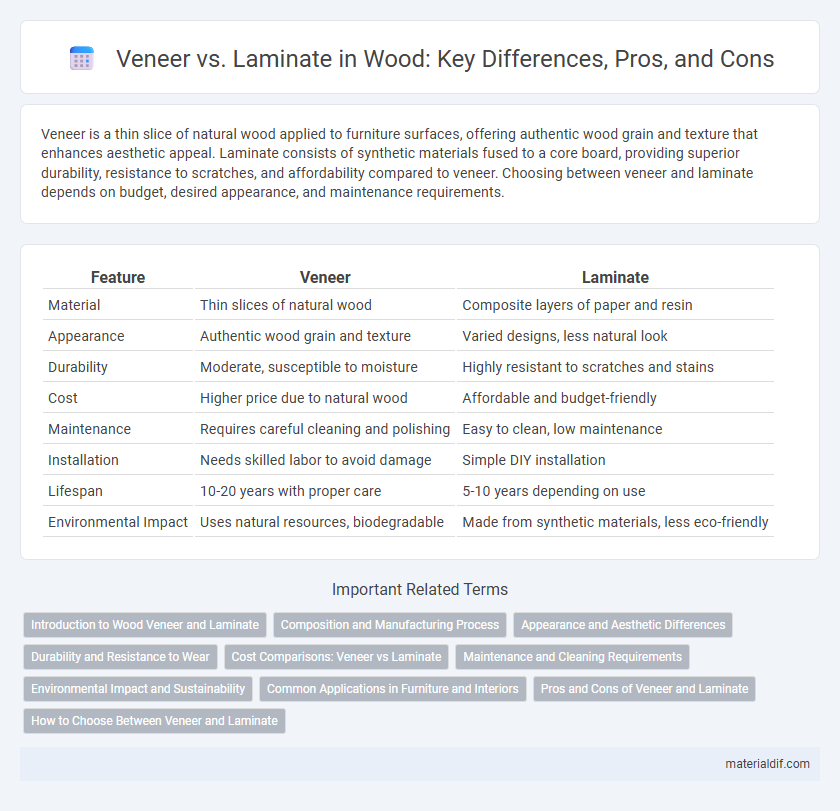Veneer is a thin slice of natural wood applied to furniture surfaces, offering authentic wood grain and texture that enhances aesthetic appeal. Laminate consists of synthetic materials fused to a core board, providing superior durability, resistance to scratches, and affordability compared to veneer. Choosing between veneer and laminate depends on budget, desired appearance, and maintenance requirements.
Table of Comparison
| Feature | Veneer | Laminate |
|---|---|---|
| Material | Thin slices of natural wood | Composite layers of paper and resin |
| Appearance | Authentic wood grain and texture | Varied designs, less natural look |
| Durability | Moderate, susceptible to moisture | Highly resistant to scratches and stains |
| Cost | Higher price due to natural wood | Affordable and budget-friendly |
| Maintenance | Requires careful cleaning and polishing | Easy to clean, low maintenance |
| Installation | Needs skilled labor to avoid damage | Simple DIY installation |
| Lifespan | 10-20 years with proper care | 5-10 years depending on use |
| Environmental Impact | Uses natural resources, biodegradable | Made from synthetic materials, less eco-friendly |
Introduction to Wood Veneer and Laminate
Wood veneer is a thin layer of natural wood sliced or peeled from a log, offering the authentic grain and texture of real wood at a more affordable cost than solid wood. Laminate consists of a photographic layer of wood grain or other patterns fused to particleboard or MDF, providing durability and resistance to scratches and moisture. Both materials serve as popular surface finishes in furniture and cabinetry, balancing aesthetics with cost-efficiency.
Composition and Manufacturing Process
Veneer is composed of thin slices of natural wood peeled or sliced from logs, preserving the unique grain patterns, and is typically bonded onto core panels using heat and pressure. Laminate consists of multiple layers of synthetic materials, including a photographic wood-grain layer topped with a clear protective overlay, fused together through high heat and pressure in a lamination process. While veneer maintains authentic wood fibers, laminate relies on resin-impregnated kraft paper and melamine resins to create a durable, uniform surface.
Appearance and Aesthetic Differences
Veneer is a thin layer of natural wood applied to surfaces, offering the authentic grain patterns and rich texture of real wood, which enhances the warmth and elegance of furniture or flooring. Laminate consists of printed photographic layers that mimic wood appearance but lack the depth and variability of genuine wood grains, resulting in a more uniform and sometimes artificial look. The natural aesthetic qualities of veneer make it preferred for high-end interiors, while laminate provides a cost-effective option with consistent patterns suitable for contemporary designs.
Durability and Resistance to Wear
Veneer offers natural wood grain with moderate durability, providing a stylish finish that can withstand daily wear but remains susceptible to scratches and moisture damage. Laminate features a high-density fiberboard core topped with a resin-impregnated decorative layer, delivering superior resistance to scratches, stains, and impact compared to veneer. For high-traffic areas or surfaces prone to heavy use, laminate generally outperforms veneer in terms of long-lasting durability and wear resistance.
Cost Comparisons: Veneer vs Laminate
Veneer typically costs more than laminate due to the use of real wood, which requires skilled craftsmanship and higher-quality materials. Laminate is a budget-friendly alternative that mimics wood grain with a synthetic overlay, offering durability at a fraction of veneer's price. The cost difference can be significant, with veneer pricing often doubling or tripling laminate costs depending on the wood species and thickness.
Maintenance and Cleaning Requirements
Veneer surfaces require gentle cleaning with a soft cloth and mild soapy water to preserve the natural wood grain and avoid damage. Laminate is highly durable and resistant to stains, allowing for easier maintenance with just regular wiping using non-abrasive cleaners. Both materials benefit from avoiding excessive moisture, but laminate generally offers superior resistance to scratches and discoloration over time.
Environmental Impact and Sustainability
Veneer, made from thin layers of natural wood, offers superior sustainability by utilizing only a small fraction of a tree while maintaining the wood's authentic appearance and durability. Laminate, composed of synthetic materials and plastic resins, often involves higher environmental costs due to non-biodegradable components and energy-intensive manufacturing processes. Choosing veneer supports responsible forest management and reduces carbon footprint compared to laminate production and disposal.
Common Applications in Furniture and Interiors
Veneer is commonly used in high-end furniture and cabinetry, providing a natural wood appearance with a thin layer of real wood adhered to a core material, ideal for upscale interiors and custom pieces. Laminate, made from synthetic materials fused together, is favored in budget-friendly furniture, kitchen countertops, and commercial spaces due to its durability, resistance to scratches, and ease of maintenance. Both materials find applications in furniture surfaces, but veneer suits aesthetic-focused designs while laminate excels in functional, high-traffic environments.
Pros and Cons of Veneer and Laminate
Veneer offers a natural wood appearance with authentic grain patterns and can be refinished for durability, making it ideal for high-end furniture and cabinetry, but it is more expensive and susceptible to damage from moisture. Laminate provides a cost-effective, highly durable surface resistant to scratches and stains, suitable for heavy-use areas, but lacks the natural warmth and texture of real wood and cannot be refinished once worn. Choosing between veneer and laminate depends on budget, desired aesthetic, and the level of wear resistance required for the application.
How to Choose Between Veneer and Laminate
Choosing between veneer and laminate depends on factors like budget, aesthetic preference, and durability requirements. Veneer offers a natural wood appearance and texture, making it ideal for high-end furniture and authentic wood finishes, while laminate provides a cost-effective, scratch-resistant surface suitable for high-traffic areas. Consider the environment where the material will be used and the desired lifespan to determine whether the warmth of veneer or the practicality of laminate best suits your project.
Veneer vs Laminate Infographic

 materialdif.com
materialdif.com